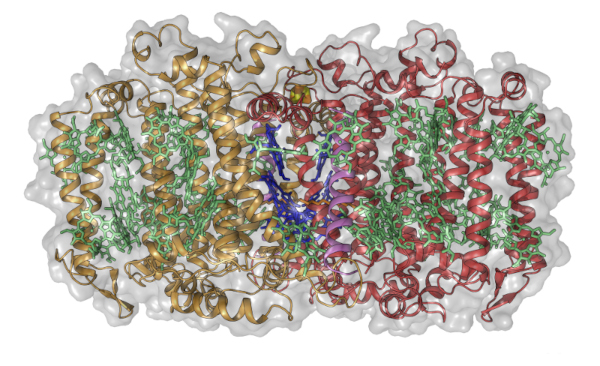The Origins of Photosynthesis in a Sun-Loving Bacteria
09/08/2017

Overall structure of the Heliobacterium modesticaldum photosynthetic reaction center. The transmembrane helices are shown in gold and red. Light-harvesting “antenna” molecules are colored green, and the electron-transfer chain is colored blue [Image credit: Christopher Gisriel].
The simplest known bacterium able to drive photosynthesis is found in muddy soils near hot springs. Heliobacterium modesticaldum is a sun-loving, soil-dwelling, thermophilic bacterium that photosynthesizes near-infrared light, unlike plants, which use different parts of visible light.
The photosynthesis reaction centers (RCs) of H. modesticaldum are thought to resemble the earliest common ancestor of all photosynthesis complexes, which evolved around three billion years ago. Thus, a clear, detailed picture of the H. modesticaldum RC would provide valuable insight into the early evolution of photosynthesis. However, the process to successfully purify an RC protein and grow the crystals needed for X-ray crystallography can be lengthy and difficult.
Researchers successfully capped 7 years of work by obtaining a high-resolution (2.2 Å) structure of the membrane protein at the heart of the photosynthetic RC of H. modesticaldum. The structure revealed details such as the interactions between light-harvesting “antenna” molecules and the electron-transfer chain, where the initial steps required to convert photon energy into chemical energy occurs.
With this data, the research team was able to make comparisons to other types of RCs, gaining new perspectives on the early evolution of photosynthesis and how nature optimized light-driven energy collection. This work will help unlock the secrets of photosynthesis, possibly leading to the development of cleaner, solar-based renewable energy.
Instruments and Facilities
X-ray macromolecular crystallograpy at the Biodesign Center for Applied Structural Discovery at Arizona State University; Beamline 8.2.1 at the Advanced Light Source at the Berkeley Center for Structural Biology at Lawrence Berkeley National Laboratory; the Structural Biology Center–CAT beamline of the Advanced Photon Source at Argonne National Laboratory.
Funding Acknowledgements
Funded by the Division of Chemical Sciences, Geosciences, and Biosciences, Office of Basic Energy Sciences (OBES), U.S. Department of Energy (DOE) Office of Science, through grant DE-SC0010575 to K.E.R., R.F., and J.H.G.; supported with x-ray crystallographic equipment and infrastructure provided by P. Fromme of the Biodesign Center for Applied Structural Discovery at Arizona State University. Berkeley Center for Structural Biology supported in part by the National Institutes of Health’s (NIH) National Institute of General Medical Sciences (NIGMS) and the Howard Hughes Medical Institute (HHMI). The Advanced Light Source (ALS) is a DOE Scientific User Facility (SUF) supported by the Director, OBES, DOE Office of Science, and operated for DOE Office of Science by Lawrence Berkeley National Laboratory (LBNL). Results derived from work performed at Argonne National Laboratory’s (ANL) Structural Biology Center (SBC) at the Advanced Photon Source (APS). SBC funded by the Office of Biological and Environmental Research (BER), DOE Office of Science. ANL is operated by University of Chicago Argonne, LLC, for the DOE Office of Science under contract DE-AC02-06CH11357.
Related Links
- BER Resource: Structural Biology Center
- Feature Story: Exploring the Roots of Photosynthesis in a Soil-Dwelling Bacterium
- News: Press release from Arizona State University
- Science highlight from the Advanced Photon Source
References
Gisriel, C., et al. “Structure of a symmetric photosynthetic reaction center–photosystem,” Science 357(6355), 1021–1025 (2017). [DOI:10.1126/science.aan5611].
